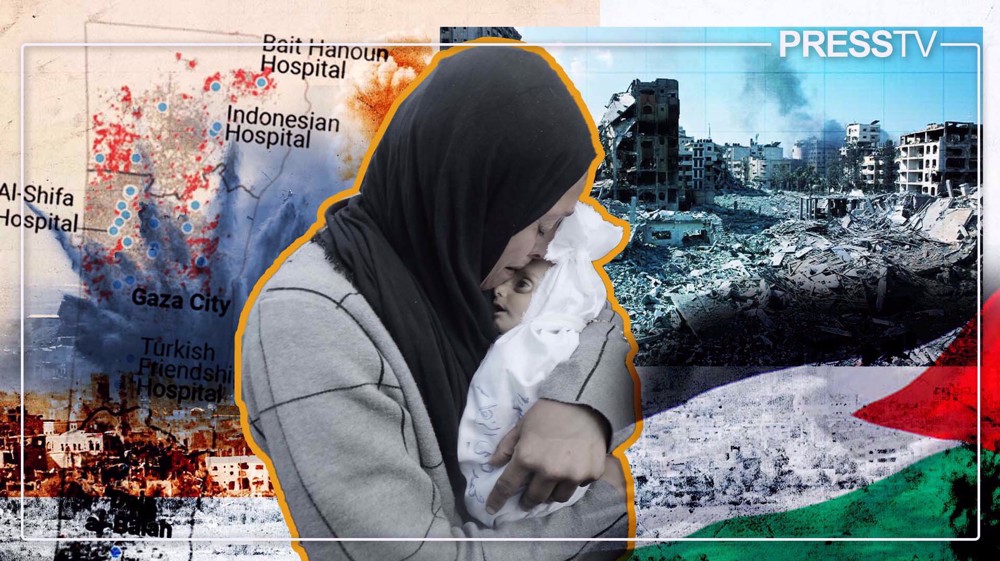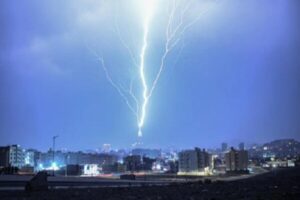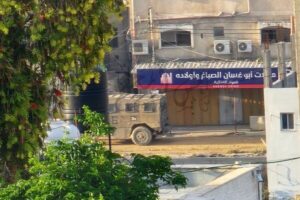By Maryam Qarehgozlou
“I keep writing and deleting because I can’t find the words to describe the level of loss we Gazans are feeling right now,” Palestinian-British journalist Yara Eid wrote in a post on X, formerly Twitter.
“Can you imagine your whole world being wiped out? Everything. The level of destruction we’re seeing is beyond any words.”
Eid, 23, who was born and raised in Gaza, has lost at least 30 members of her immediate family, including 17 children, amid the Israeli-American genocidal war on the besieged territory since October 7.
The blockaded territory has seen indiscriminate bombings, targeting civilian facilities such as residences, hospitals, schools and universities, with most of the casualties being children and women.
“Our homes, our landmarks, our schools, our universities, our restaurants, literally everything… Israel’s intent was to always remove Gaza from the map. They destroyed our city intentionally. They bombed our ancient landmarks to remove any proof of Palestinian history,” she hastened to add.
Staggering death toll
According to Palestinian health authorities, the death toll in Gaza has exceeded 15,500, most of them children and women, with more than 40,000 others wounded.
Among those killed include nearly 6,400 children and 4,250 women, making up nearly 70 percent of the reported fatalities in the besieged territory since October 7.
More than 700 were killed on a single day after the expiration of the temporary truce this week.
Between October 7 and December 1, the fatality toll included at least 207 health workers and 112 United Nations staff, according to the Gaza Ministry of Health.
The Palestinian Journalists’ Syndicate also reported the killing of at least 77 journalists in Gaza.
Eighteen-year-old Dima al-Lamdani who dreamed of being a successful businesswoman while growing up in the Shati refugee camp in Gaza lost 17 members of her family after they were forcibly evacuated to the south in the first week of the war.
“I am crumbled now. No dreams, no hopes, no plans. I can’t imagine my life without my mother and sister and father,” she was quoted as saying by The Guardian. “There is no place that is safe.”
The figures also suggest that hundreds of families were removed from Gaza’s population registry as all members of those families were killed together in deadly airstrikes.
On October 15, only a week into the war, a report from the Palestinian Ministry of Health stated that 47 families—consisting of over 500 civilians—were wiped from the civil registry.
The number rose to a staggering 825 families by October 28, according to reports by the Palestine News and Information Agency.
The figures have not been updated ever since, however, with the death toll now approaching 16,000, aid agencies say there are good reasons to believe that the number could be much higher.
On November 22, at least 52 members of one family were killed in the Jabalia refugee camp in northern Gaza, Palestinian Foreign Minister Riyad al-Maliki confirmed at the time
“Only this morning, from the Qadoura family in Jabalia, 52 people have been wiped out completely, killed. I have the list of the names, 52 of them. They were wiped out completely from grandfather to grandchildren,” he said.
On Saturday, more than 100 more Palestinians were killed and many more were injured in an Israeli missile attack on the same refugee camp, one of the largest camps in the territory.
Focus on southern Gaza
At the time of writing this, the southern Gaza Strip is reeling under heavy Israeli bombardment.
James Elder, a spokesperson for the UN Children’s Agency (UNICEF), in a statement posted on X on Sunday, called it the “worst bombardment” since the beginning of Israel’s aggression on October 7.
“I feel like I’m almost failing in my ability to convey the endless killing of children here,” he said in a separate video message from the Nasser Hospital in the southern Gaza city of Khan Yunis.
UN High Commissioner for Human Rights Volker Türk also warned on Sunday that no place in Gaza is safe amid Israel’s fresh air raids and evacuation orders.
“As a result of Israel’s conduct of hostilities and its orders for people to leave the north and parts of the south, hundreds of thousands are being confined into ever smaller areas in southern Gaza without proper sanitation, access to sufficient food, water and health supplies, even as bombs rain down around them,” he said in a statement.
“I repeat, there is no safe place in Gaza.”
The UN rights chief also stressed the need for an end to the spell of Israeli violence in Gaza.
“Silence the guns and return to dialogue – the suffering inflicted on civilians is too much to bear. More violence is not the answer. It will bring neither peace nor security,” he noted.
Short-lived truce deal
On November 22, an agreement was reached for a temporary truce between the Hamas resistance group and the Israeli regime, brokered by Qatar and Egypt after marathon negotiations.
The four-day truce agreement went into effect on November 24 and was extended twice before it ended on Friday. Under the truce, fighting was paused and humanitarian aid was allowed to enter Gaza.
As part of the truce agreement, Hamas released 110 out of 240 Israeli captives held in Gaza in exchange for the release of 240 Palestinian abductees held illegally in Israeli prisons.
However, prisoners’ rights groups report that at the same time, Israel has abducted about the same number of Palestinians in the occupied West Bank and East al-Quds, as part of its bloody crackdown on Palestinians in the wake of the recent onslaught in Gaza.
Immediately after the truce expired, even though talks were underway to extend it, Israel began pounding the crowded southern Gaza and drove up the death toll after the short-lived truce deal.
The director-general of the Government Media Office in Gaza was quoted as saying on Sunday that more than 700 Palestinians were killed in Gaza in one day.
Widespread displacement
According to the United Nations, 1.8 million people, making up nearly 80 percent of Gaza’s population, have been internally displaced amid the Israeli regime’s aggression.
There is still no safe place to go and shelters are already teeming with people, according to sources.
On Friday, the Israeli military released a map, in which the Gaza Strip is divided into hundreds of small areas. The map is intended to facilitate orders to evacuate people to specific areas.
The United Nations Office for the Coordination of Humanitarian Affairs (OCHA) said that the following two days after sharing the map, various areas, accounting for about 28 percent of the territory, were marked in the map for evacuation.
On Sunday, the Tel Aviv regime ordered immediate evacuation of an area covering about 20 percent of Khan Younis city in southern Gaza.
Before the war, this area was home to nearly 117,000 people. Now, it includes 21 shelters with about 50,000 internally displaced persons (IDPs), the vast majority of whom were previously displaced from the north.
Also, residents in localities east of Khan Younis – Al Qarara, Khuza’a, Abasan and Bani Suheila – were ordered to move further south to Rafah. These areas, OCHA says, were home to about 352,000 people before the outbreak of the Israeli-American war.
“Subsequently, thousands of IDPs arrived at Rafah governorate, increasing the strain on the humanitarian response, including on already overcrowded shelters,” OCHA warned.
Although the north of Gaza is almost unlivable due to the intense air and ground strikes by Israeli forces, tens of thousands of Gazans, including the sick and disabled, are likely to remain in the north.
On Saturday, the Israeli military ordered the evacuation of the eastern parts of Gaza City (Ash Shuja’iyeh, Az Zaytoun and the Old City) and of Jabalia, both in the north, and instructed residents to move towards the western areas of Gaza City.
OCHA said the areas were home to about 415,000 people.
“The scale and scope of population movements following these orders remains unclear,” the humanitarian office said in a statement.
UN High Commissioner for Human Rights Volker Türk said on Friday that the surviving Gazans risk being forcibly displaced to already “severely over-crowded and unsanitary parts of Gaza.”
He described the situation “beyond crisis point.”
The overcrowding and poor sanitary conditions at shelters have raised concerns, especially about vulnerable groups such as children, people with disabilities, women who are pregnant or breastfeeding, people who are recovering from injuries or surgeries, and those with compromised immune systems.
“There have been significant increases in some communicable diseases and conditions such as diarrhea, acute respiratory infections, skin infections and hygiene-related conditions like lice. There are also initial reports of disease outbreaks, including hepatitis A,” OCHA said.
Extensive damage
According to the Gaza Ministry of Public Works and Housing, as of Saturday, over 60 percent of Gaza’s housing units were damaged or totally destroyed.
More than 50,000 housing units have been completely destroyed and 250,000 housing units are partially damaged by the relentless bombing over the past two months, it said.
Also, 339 education facilities have been partially or fully damaged and nearly 625,000 school students in the territory have no access to education.
At least 20 water, sanitation and hygiene (WASH) facilities, have been damaged, the ministry added, which has gravely impacted people’s access to drinking water.
At least 3 churches and 88 mosques were also damaged in the same period, while 11 bakeries were smashed to the ground, it added.
Health crisis
Hospitals and healthcare centers in Gaza are no longer operational amid the regime’s relentless bombardment and ground offensive, coupled with an acute shortage of medicine and fuel.
Some hospitals have completely lost power as the generators have run out of fuel. Fuel at the hospitals that did not cease their operations is being severely rationed, according to the UN.
World Health Organization (WHO) says the bed capacity at present across the territory is 1,400, down from 3,500 before the war.
According to the UN, 26 hospitals and 55 healthcare centers went out of service in Gaza as of December 2, adding that only six out of 24 hospitals in Gaza City and North Gaza are partially operational.
“None of these six hospitals have surgery capacity,” it added.
UN also reported that in the south, 12 hospitals are partially functional.
“Only one of the currently functional hospitals [in the south] has the capacity to treat critical trauma cases or perform complex surgery,” the world body said.
There are also reports of rising deaths among patients. UN said at least 1,000 patients with kidney failure, more than 2,000 cancer patients, and 130 neonates in incubators “are at high risk.”
Water shortage
The total siege on the strip has also led to food scarcity and an acute lack of water.
According to the UN, only 5 percent of Gaza’s water needs are currently being met. It said that in the northern governorates, people have no access to clean water.
The fuel shortage has affected 60 water wells, two desalination plants, sewage stations and pumps, and wastewater treatment, it added.
“There has been almost no improvement in the access of residents in the north to water for drinking and domestic purposes for weeks.”
The lack of clean water has led to an outbreak of diseases in crowded shelters, such as cholera.
The UN has also expressed concern over the lack of food in the north amid widespread destruction and chaos.
“The situation is catastrophic and World Food Program’s stocks inside Gaza are running out,” the world body said, adding that the last functioning mill in Gaza was destroyed on November 15.
On average, people have to wait for 4 to 6 hours in queues to receive half of the normal bread portion.
Aid agencies keep warning that malnutrition and polluted water supplies could plunge the besieged coastal territory into a crisis that will outlive the war, which is now in its eighth week.
In a statement on Saturday, Dr Shameela Islam-Zulfiqar of Action For Humanity, an international aid agency working in Gaza, said disease is going to take hold in Gaza due to “purposeful dismantling” of healthcare.
“A desperately frail population is on the verge of a debilitating and crippling public health catastrophe. As we’ve seen in every other conflict in history, war breeds disease,” she noted.
No electricity
Data from the Gaza Electricity Distribution Company (GEDCO), shared by the United Nations on Sunday, shows that the blockaded strip has had no electricity since October 11.
The data also revealed that even before the war, from January to September 2023, Gaza only averaged 13.3 hours of electricity per day.
“For the past decade, the Gaza Strip has suffered from a chronic electricity deficit, which undermined already fragile living conditions,” the UN update said.




